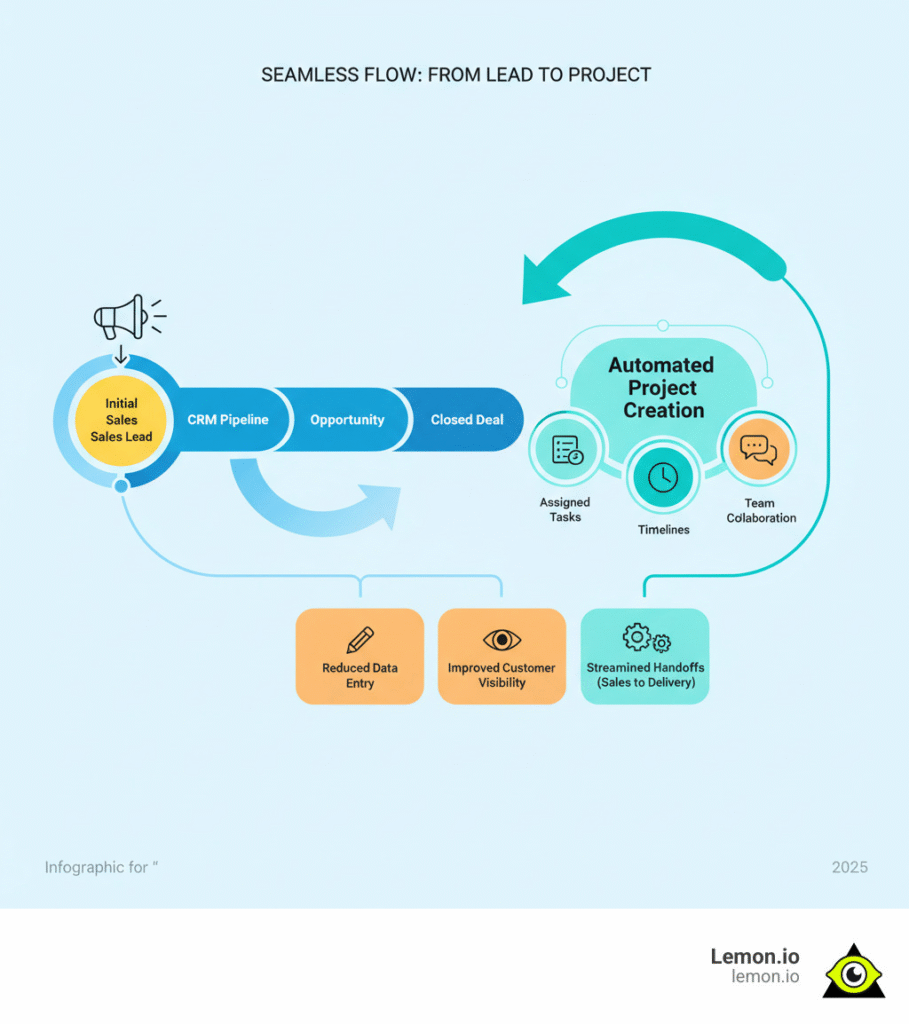Project management and crm systems have traditionally operated in silos, creating inefficiencies that drain resources and frustrate teams. Here’s what you need to know about integrated solutions:
Quick Comparison of Integrated vs. Separate Systems:
- Integrated Solutions: Single platform, unified data, seamless workflows, better customer experience
- Separate Systems: Data silos, manual transfers, fragmented customer journey, higher costs
- Key Benefits: 28% reduction in financial losses, improved team collaboration, faster project delivery
- Best For: Agencies, consulting firms, service-based businesses, growing startups
Managing a business without integrating your customer relationship management (CRM) and project tracking tools feels like juggling too many things at once. The challenge is real: your sales team captures leads in the CRM, but project managers work in separate systems. Customer data gets lost, project updates never reach client-facing teams, and hours are wasted copying information between platforms. The result is missed deadlines, confused customers, and frustrated employees.
There’s a better way. Integrated solutions connect customer relationships directly to project execution. When a deal closes, it can automatically become a project with tasks, timelines, and team assignments. This allows customer service to see project status instantly and helps project managers understand client history.
This isn’t just about convenience; it’s about survival. Companies using integrated project management and crm systems report faster project delivery, higher customer satisfaction, and better team collaboration.
I’m Aleksandr Volodarsky, and I’ve grown lemon.io from $2.7M to $10M by understanding how project management and crm integration transforms business operations. I’ve seen how the right systems accelerate growth and eliminate operational friction.

The Core Difference: CRM vs. Project Management Software
Think of your CRM as the friendly host at a restaurant, managing customer relationships and preferences. Your project management software is the kitchen manager, ensuring every order is prepared and delivered on time. Both are essential but serve different purposes.
Understanding CRM: Your Customer Relationship Hub
Customer Relationship Management (CRM) software helps you build and maintain long-term customer relationships. It’s customer-facing and acts as your business’s digital memory. CRMs excel at:
- Contact Management: Storing every conversation, email, and interaction in one place.
- Sales Pipeline Tracking: Showing where each potential deal stands.
- Lead Tracking: Nurturing prospects through a single system.
- Communication History: Creating a complete picture of each customer relationship.
Project Management: Your Internal Command Center
Project management (PM) software is internal-facing and focused on finite projects with clear start and end dates. It answers the question, “How do we get this work done efficiently?” Key functions include:
- Task Management: Breaking big projects into manageable pieces.
- Timelines and Gantt Charts: Visualizing what needs to happen and when.
- Resource Planning: Ensuring you’re not overloading your team.
- Budgeting: Keeping projects profitable.
The Key Distinction
CRMs nurture long-term relationships, while PM software manages work with specific deadlines. The magic happens when these two worlds connect, giving projects full client context and giving client-facing teams visibility into project progress. That’s where integrated project management and crm solutions transform how businesses operate.
Focus Area |
Details |
|||
|---|---|---|---|---|
CRM |
Contact Management – Building customer databases |
Sales Pipeline – Tracking deals from lead to close |
Lead Tracking – Nurturing prospects over time |
Communication History – Recording every customer touchpoint |
Project Management |
Task Management – Breaking work into actionable items |
Timelines/Gantt Charts – Visualizing project schedules |
Resource Planning – Optimizing team capacity |
Budgeting – Controlling costs and maximizing profitability |
Understanding these differences explains why disconnected systems cause struggles and why integration delivers powerful results.
The Power of Integration: Key Benefits of Combining Project Management and CRM

When project management and CRM systems work together, you get a single source of truth where all customer and project information lives. Sales teams know the status of their client’s project, and project managers understand the full customer relationship. Everyone works from the same playbook.
The results speak for themselves. Research shows that investing in project management can reduce financial losses by 28%, and CRM integration multiplies those benefits. An integrated system creates a 360-degree customer view, boosting operational efficiency and fostering cross-department alignment as teams spend less time hunting for information and more time delivering value.
Improved Customer Experience and Satisfaction
Integration shines in the customer experience. Instead of customers repeating themselves to different departments, they get a seamless customer journey. Key benefits include:
- Smooth Sales-to-Delivery Handoff: Project managers start with complete context on client needs, budget, and expectations, as sales promises flow directly into the project plan.
- Faster Issue Resolution: Support teams can instantly see customer history and project status, allowing them to solve problems immediately.
- Proactive Communication: Systems can automatically notify clients of milestones or alert teams to potential issues before they become crises.
- Consistent Service: Every interaction builds on the last, creating trust and loyalty. For more on this, see this guide on customer service.
Streamlined Workflows and Team Collaboration
Integrated project management and CRM systems replace messy spreadsheets and scattered notes with a central hub for all information. This leads to:
- Elimination of Data Silos: Everyone sees the same customer and project information, all the time.
- Reduced Manual Data Entry: When a deal closes, project details can populate automatically, freeing up your team to focus on valuable work.
- Automated Workflows: Repetitive tasks like project creation, team assignments, and welcome emails can be triggered automatically.
- Centralized Communication and Visibility: All client interactions are logged in one place, giving sales reps and project managers shared visibility into project progress and sales context.
This creates an environment where teams can do their best work without fighting their tools.
Data-Driven Insights and Better Decision-Making
Combining project management and CRM data provides insights that neither system could offer alone. You gain the ability to:
- Generate Unified Reports: Track the entire lifecycle from lead to completed project, identifying profitable client types and common project delays.
- Create Accurate Forecasts: Combine sales pipeline data with project capacity to produce realistic revenue projections and delivery dates.
- Optimize Resources: See team workloads alongside incoming sales to know when to hire or focus on business development.
- Analyze Project Profitability: Connect what you charge to what projects actually cost, identifying which clients and project types are most profitable.
- Identify Customer Behavior Trends: Analyze the full customer lifecycle to see which clients request scope changes or lead to referrals, helping you refine processes.
How Lemon.io Can Help: Custom-Built Integrated Solutions

Off-the-shelf project management and crm solutions often feel like a suit that doesn’t quite fit. Forcing your unique business processes into a generic tool can create more problems than it solves. This is where custom development comes in—building software that fits your business perfectly.
At Lemon.io, we connect businesses with the top 1% of software engineers who can turn your unique needs into custom solutions. If existing platforms are too rigid, complex, or missing a crucial feature, our developers can:
- Tailor workflows to your business, seamlessly connecting sales, marketing, and project delivery.
- Integrate CRM and project management for your unique needs, building bridges between existing tools or creating a new, all-in-one system.
We know that sometimes only a custom-built solution can open up true efficiency. If you’re ready for a system that gives you a competitive edge, we invite you to hire vetted software developers to build your custom solution.
Key Evaluation Criteria for Your Integrated Solution
Choosing the right integrated solution is a major decision. Here are the key criteria to consider:
- Scalability: Will the solution grow with your business? Ensure it can handle more users, data, and project complexity without performance issues.
- User Interface (UI) and User Experience (UX): Is it easy to use? An intuitive interface is critical for team adoption.
- Integration Capability: How well does it connect with your existing tools, like accounting or marketing software? Look for native integrations or robust API access.
- Price: Consider the total cost of ownership, including per-user fees, setup, and add-ons. Ensure free or cheap tiers won’t force expensive upgrades later.
- Security: The platform must have strong security measures, including data encryption, access controls, and compliance with standards like GDPR.
- Support: Is reliable help available when you need it? Good support is crucial during setup and troubleshooting.
Features to Look for in a Combined Project Management and CRM Tool
Look for a unified system with features designed to work together. Key features include:
- Comprehensive Task Management: Assign tasks, set deadlines, track progress, and manage dependencies.
- Gantt Charts and Kanban Boards: Visualize project timelines and workflow stages.
- Pipeline Visualization: A clear, customizable sales pipeline to track leads and opportunities.
- Robust Contact Management: Detailed contact profiles with a full history of communications.
- Workflow Automation: Automate repetitive tasks like creating a project when a deal closes.
- Reporting and Analytics: Integrated dashboards for insights into sales forecasts, project profitability, and team utilization.
- Third-Party Integrations: Seamless connections to your other essential business software.
- Client Portals: A secure space for clients to view progress, give feedback, and access documents.
- Time Tracking and Expense Management: Essential for accurate billing and profitability analysis.
Assessing Your Specific Needs and Budget
Finding the right tool requires looking at your unique situation:
- Team Size and Project Complexity: Small teams may prefer simple tools, while larger teams with complex projects need advanced features like detailed permissions and resource management.
- Industry Requirements: A tech staffing agency needs different features (e.g., recruiting tool integrations) than a consulting firm (e.g., client portals and time tracking).
- Existing Tech Stack: Ensure the new solution integrates smoothly with your current software to avoid creating new data silos.
- Simplicity vs. Power: Balance ease of use with the need for advanced features. Some powerful tools have steep learning curves.
- Free vs. Paid Tiers: Use free trials to test basic functionality, but determine if a paid plan is necessary for advanced features, higher user limits, and better support.
Overcoming Potential Challenges in Integration
Integrating a new system can present challenges, but they are manageable with proper planning.
Common Problems:
- Implementation Complexity: Setting up the system to match your workflows can be difficult.
- Data Migration: Moving data from old systems without errors or loss is a critical, often complex step.
- User Training and Adoption: Teams need proper training and support to accept a new system and avoid reverting to old habits.
- Feature Bloat: Too many overlapping features can cause confusion rather than improve processes.
- High Software Costs: Enterprise-grade solutions can be expensive if your business doesn’t require their full capabilities.
How to Succeed:
- Plan Thoroughly: Define your needs, workflows, and goals before choosing a tool.
- Use a Phased Implementation: Roll out the system in stages, starting with a small group to gather feedback.
- Invest in Training: Provide comprehensive training and support to ensure your team understands the benefits.
- Cleanse Your Data: Before migration, clean up existing data to remove duplicates and fix inconsistencies.
- Seek Expert Guidance: For complex integrations or custom needs, expert help is invaluable. This is where Lemon.io developers excel. They can build custom integration layers, assist with data migration, or develop a bespoke solution custom precisely to your workflows, bypassing the limitations of generic tools.
By anticipating these challenges, you can ensure a smoother transition and open up the full power of an integrated system.
Frequently Asked Questions about Project Management and CRM
Here are straight answers to common questions about integrating these systems.
Can a CRM be used for project management?
Yes. Modern project management and crm platforms have evolved beyond simple contact management. Many now include powerful, built-in project management modules.
When a lead converts, the system can automatically create a new project, assign tasks, and track progress, all tied to the customer’s profile. This gives your project team instant access to sales history and communication logs, ensuring the delivery team knows what was promised. It centralizes customer and project data, creating a seamless workflow.
What is the main advantage of a combined system?
The single biggest advantage is creating a single source of truth. Instead of sales data in one system and project information in another, everything is unified. This eliminates information silos and improves collaboration.
- Sales teams can see project status.
- Project managers understand the sales context.
- Customer service can provide real-time updates.
The result is a seamless connection between sales and delivery, which leads to greater internal efficiency and a better customer experience. Customers notice the difference when they receive consistent information and faster problem resolution.
How do I integrate my existing CRM and project management tools?
You have several options for integration:
- Native Integrations: The easiest route. Many popular tools are designed to connect directly with each other out of the box.
- Third-Party Connectors: Platforms like Zapier act as translators between your apps, allowing you to create automated workflows without code.
- Custom API Development: For complex business rules, unique data requirements, or specialized software, a custom solution is best. This is a core strength of our developers at Lemon.io.
To see how other companies have solved this, check out these benefits of integrating a tracking tool with PM software. The key is to first map your data flow—what information needs to move, how often, and in which direction. If your tools aren’t cutting it, our team can assess your needs and recommend the best path, whether it’s connecting existing tools or building a new custom solution.
Conclusion
Embracing an integrated project management and crm system is a strategic shift that can revolutionize your business. By bringing these two systems together, you eliminate data silos, streamline workflows, and provide a seamless customer experience from start to finish.
The benefits are clear: improved team collaboration, a 360-degree customer view, and data-driven insights that lead to smarter business decisions. This integration is proven to reduce financial losses and boost efficiency.
Your path forward depends on your needs. You can choose an all-in-one platform, connect specialized tools with integrations, or opt for a custom solution. Off-the-shelf products can be limiting, forcing you to adapt your processes to their rigid frameworks.
Custom development is the ultimate solution for businesses with unique workflows. A custom system adapts to your business, not the other way around. At Lemon.io, we connect you with vetted developers who can build a system that works exactly how you need it to, freeing you from the limitations of generic software.
Ready to transform how you manage customers and projects? Hire vetted software developers to build your custom solution and find what’s possible when technology truly serves your vision.










